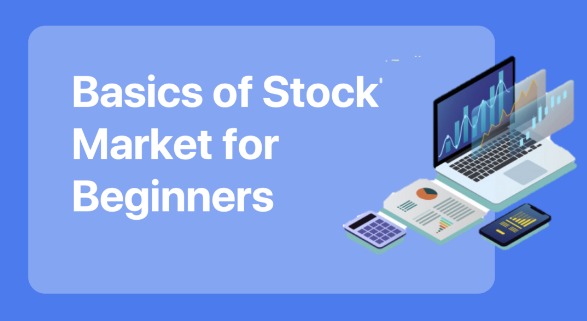
In your daily lives, you must have come across terms like “stock market” and “share market.” What is the stock market? If you are only an average investor, you can get by without giving this word much thought. However, having some fundamental understanding is crucial if you plan to stick with it and want to learn how to trade shares. A stock exchange is a fundamental marketplace where buyers and sellers can transact in publicly traded shares during market hours. There are two main stock markets in India. The two are the National Stock Exchange (NSE) and the Bombay Stock Exchange (BSE). So let’s start by learning the basics of the stock market.
What exactly is a stock market?
Stocks, often known as equities, are financial instruments that give stockholders ownership stakes in public companies. It represents a genuine investment in the company, and if you hold all of the company’s shares, you have complete influence over its management. The collection of stocks that may be purchased and sold by the general public on a number of different exchanges is referred to as the stock market.
What is the source of the stock? Public companies issue stock to raise money for their operations. Investors that are confident in the company’s future success purchase those stock issues. Any dividends and price increases for the shares are distributed to the shareholders. If the company runs out of money, they can also see their investment decline in value or disappear totally.
The stock market is essentially a form of aftermarket where shareholders can sell their shares to investors who wish to purchase them. This trading occurs on a stock exchange, like the Nasdaq or the New York Stock Exchange. The exchange floor used to be a physical site where traders would conduct their transactions in the past, but today almost all trading is conducted electronically.
Usually, when news sources state, “The market was up today,” they are referring to the performance of the Dow Jones Industrial Average or the Standard & Poor’s 500. The Dow includes 30 significant firms, whereas the S&P 500 is made up of about 500 large publicly traded corporations in the United States. These monitor the stock collections’ performance and display how they fared both on the trading day in question and over the course of time.
The Dow and the S&P 500, though frequently referred to as “the market,” are actually stock indices. These indexes represent a number of the biggest U.S. corporations, but they do not represent the entire market, which consists of thousands of publicly traded companies.
Naturally, a brokerage account is a requirement for stock investments. Here are nine more tips for stock market investment to help you get started.
Basics of stock market: Bull Market vs. Bear Market
A market that is expanding and where economic conditions are typically favorable is known as a bull market. A bear market develops when the economy is contracting and the majority of the stocks are losing value. These terms also describe how investors feel about the market and the resulting economic trends, because investor attitudes have a big impact on the financial markets.
A steady rise in prices is a hallmark of a bull market. In the context of equity markets, a “bull market” refers to an increase in the share prices of corporations. Investors frequently believe that an uptrend will last for the long term during such circumstances. The country’s economy is normally solid in this scenario, with high employment levels.
A bear market, on the other hand, is one that is falling. Unless a market has dropped 20% or more from recent highs, it is typically not referred to as a true “bear” market. Share prices are consistently falling during a bad market. As a result, there is a downward trend that investors predict will continue, which feeds the downward cycle. In a bear market, businesses start to fire workers, which slows down the economy and increases unemployment.
Demand and Supply of securities
In a bull market, there is a large demand for securities and a small supply. To put it another way, a lot of investors want to acquire assets, but not as many are ready to sell them. As investors fight for available stock, share prices will increase as a result.
The opposite is true in a bear market: more people are looking to sell than buy. Because there is a far greater supply than demand, share prices fall.
How to invest in the stock market- 9 tips for beginners
1. Buy the right investment.
2. If you’re a beginner, stay away from individual stocks.
3. Make a diversified investment portfolio.
4. Be ready for a downturn
5. Before making an actual investment, try a simulator.
6. Keep your long-term portfolio a priority.
7. Stop trading short-term right away.
8. Over time, continue to invest
1. Buy the right investment
It’s much easier to say than to purchase the appropriate stock. Anyone may observe a stock that has performed well in the past, but it is much harder to predict how a stock will perform in the future. You need to be willing to put in a lot of effort to manage your investments and analyse companies if you want to be successful investing in individual stocks.
It’s very challenging for an individual to succeed over time. When you start looking at statistics, you’ve got to remember that the professionals are looking at each and every one of those companies with much more rigour than you can probably do as an individual.
If you’re examining a company, you should consider its fundamentals, such as its price-earnings ratio (P/E ratio) or earnings per share (EPS). The company’s management team should be examined, its competitive advantages should be assessed, and its financials, especially its income statement and balance sheet, should be studied. Even these things are only the beginning.
According to Keady, buying stock in your favorite firm or product on the open market isn’t the best method to invest. Additionally, remember that past performance is no guarantee of the future, so don’t place too much stock in it.
Even in good times, it will be difficult to analyze the business and predict what will happen next.
2. If you’re a beginner, stay away from individual stocks
Everyone has heard someone discuss a significant stock gain or a wise stock selection.
What they fail to remember is that they frequently neglect to mention the specific investments they also hold and which performed incredibly poorly over time. As a result, occasionally, people have irrational expectations about the kinds of returns they may expect from the stock market. Furthermore, they occasionally mix together skill with luck. It’s possible to strike it lucky while choosing a specific stock. Being fortunate over time while avoiding those severe downturns is difficult.
Remember that in order to consistently profit from specific equities, you must possess information that the market’s forward-looking pricing does not already reflect. Remember that there is a buyer for every seller in the market who is equally confident they will make a profit.
The likelihood of you surpassing that is not very good if you’re a newbie. There are loads of brilliant individuals doing this for a job.
An index fund, which can be either a mutual fund or an exchange traded fund, is a substitute for individual equities (ETF). Many, or even hundreds, of equities are held by these funds. Additionally, every share of a fund you buy gives you ownership of every company on the index.
Mutual funds and ETFs, in contrast to stocks, may have yearly fees, while other funds are cost-free.
3. Make a diversified investment portfolio
The fact that an index fund includes a variety of stocks right away is one of its main benefits. For instance, if you purchase equities in a broadly diversified fund based on the S&P 500, you will have exposure to hundreds of companies in numerous industries. But you might alternatively invest in a fund that is just narrowly diversified and that focuses on one or two industries.
Diversification is crucial because it lowers the likelihood that any single stock in the portfolio will significantly detract from overall performance, which actually increases overall returns. In contrast, if you only purchase one stock, you are effectively putting all of your eggs in that one basket.
Purchasing an ETF or mutual fund is the simplest approach to build a diverse portfolio. You don’t need to conduct any investigation on the businesses contained in the index fund because diversification is already incorporated into the products.
It might not be the most thrilling, but it’s a good place to start. And once more, it disabuses you of the notion that you’re going to be so wise that you’ll be able to choose the stocks that are going to go up, won’t go down, and know when to go in and out of them.
Diversification doesn’t merely refer to holding a variety of equities. Additionally, it refers to investments dispersed throughout a variety of businesses because stocks in related industries may move in the same way for the same reason.
4. Be ready for a downturn
For the majority of investors, taking a loss on their assets is the most difficult challenge. You will occasionally experience losses as a result of the stock market’s volatility. You’ll need to be tough to handle these losses, or else you’ll panic and buy high and sell cheap.
Any single stock you hold shouldn’t have a significant impact on your overall performance as long as you diversify your portfolio. Purchasing individual stocks might not be the best option for you if it does. No matter how hard you try, even index funds will vary, so you can’t completely eliminate risk.
We have this tendency to attempt to pull back or to second-guess our readiness to be in if the market changes.
Because of this, it’s critical to be ready for sudden downturns, like the one that occurred in 2020. To earn enticing long-term returns, you must endure short-term volatility.
Since stocks don’t have principal guarantees, it’s important to understand that investing carries the risk of financial loss. A high-yield CD can be preferable if you’re seeking a guaranteed return.
Keady warns that it might be challenging for novices and even seasoned investors to comprehend the idea of market volatility.
One of the interesting aspects is that when the market is declining, people perceive it as volatile. However, from a statistical perspective, the market is similarly unstable when it is ascending. People should emphasize that the volatility they are observing on the upside will also be there on the downside.
5. Before making an actual investment, try a simulator
Using a stock simulator is one way to enter the world of investing without taking any risks. Your real money is not at risk if you use a virtual trading account on the internet. You’ll be able to decide how you would respond if you actually had the money to gain or lose.
According to Keady, “it can be incredibly beneficial because it can help people overcome the assumption that they’re wiser than the market, that they can always choose the greatest stocks, and that they can always buy and sell in the market at the proper time.”
Considering your reasons for investing will help you decide if stock investing is right for you.
It could be a good idea to test a simulator or watch several stocks to see if you could truly do it if your plan is to somehow outperform the market and choose all the top stocks. If you’re more committed to investing over time, then almost everyone, including myself, believes that having a diverse portfolio, such as that offered by mutual funds or exchange traded funds, will be far better for you.
6. Keep your long-term portfolio a priority.
Investing should be a long-term endeavor. Additionally, he advises you to cut yourself off from the 24-hour news cycle.
You’ll be able to cultivate patience by avoiding the daily financial news, which you’ll need if you want to continue in the investment game for the long run. Additionally, it helps to only glance at your portfolio occasionally to prevent over-anxiety or over-elation. These are excellent pointers for novice investors who haven’t yet learned to control their emotions.
The news cycle can occasionally turn completely negative, which can be exhausting for people.
Setting up a calendar and deciding in advance when you’ll be analysing your portfolio is one method for novices. By adhering to this rule, you’ll avoid selling out of a stock during a period of market turbulence or failing to reap the full rewards of a profitable investment.
7. Get going now
It usually doesn’t work well to wait for the ideal moment to invest in the stock market. Nobody can say with absolute confidence when it is best to enter. Additionally, investment is a long-term endeavor. There is no ideal moment to begin.
One of the most important things about investing is to start rather than just think about it. And now, begin. Because compounding is what can really boost your profits if you invest now and frequently throughout time. It’s crucial to actually start investing and have a savings programme in place so that we can eventually attain our objectives.
8. Stop trading short-term right away.
Knowing whether you are investing for the long run or the short term can also help you decide on your approach and whether you even need to be investing. Short-term investors can have irrational expectations about their ability to expand their money. And studies indicate that the majority of short-term investors, including day traders, lose money. You’re up against powerful investors and smart computers that might know more about the market.
New investors should be aware that regularly purchasing and selling stocks might be costly. Even though a broker advertises a zero headline trading commission, it might nevertheless result in taxes and other expenses.
If you invest for the short term, you risk not having your money when you need it.
A savings account, money market account, or short-term CD may be preferable options for short-term money, depending on your financial objectives. Investors are frequently advised by experts to only make stock market investments if they can maintain those investments for a minimum of three to five years. You should definitely put money that you will need in the next several years for a specified reason in low-risk investments like a high-yield savings account or a high-yield CD.
9. Continue to invest over time
It can be simple to invest all of your money in the market and feel accomplished. However, individuals that achieve true wealth do so over time by continually increasing their investments. This entails having good saving habits, such as setting aside a portion of your income so you can invest it in the stock market. You’ll be able to invest more money and accelerate the growth of your wealth.
How do I invest in the stock market?
You must open a depository and trading account in order to invest in the stock market. That is required.
After that, select the shares you want to buy and sell by logging into your trading and Demat accounts. Make sure you have enough money in your account to purchase those shares. You must provide the required supporting paperwork. Your account will be opened after the verification process is complete.
The price range at which you want to buy and sell shares is up to you to decide. then watch for the buyer or seller to carry out that demand.
You either receive shares or money for the stocks you purchased or sold once the transaction is complete.
What Is Traded On The Stock Exchange?
The four categories of financial instruments traded on the stock market are as follows: The list is as follows:
Shares: A share is a portion of a company’s stock. Shareholders are people who own stock in a corporation.
Bonds: Companies issue bonds to the general public in order to raise capital. Bonds are the issuer’s collateral for loans. Instead of going to a bank, the business gets its funding from the bond buyers. It provides a fixed rate of return to its investors.
Mutual Funds: Companies that pool money from many people and invest it in a variety of securities, including stocks, bonds, and short-term loans, are known as mutual funds.
Derivatives: Financial products known as derivatives derive their value from an underlying asset, such as stocks, currencies, commodities, etc. Common examples of derivative instruments include futures and options.
Types of Share market
Primary markets and secondary markets are additional categories for stock markets.
Primary market
A company enters the primary market when it registers for the first time at the stock exchange to raise money through shares. This is known as an initial public offering (IPO), and it allows the company to become publicly registered and allow market participants to trade its shares.
Secondary Market
New securities issued by a corporation are exchanged on the secondary stock market after being sold in the primary market. Investors have the chance to purchase and sell shares among themselves at the current market value in this situation. Investors typically carry out these transactions through a broker or other type of intermediary who may make this possible.
Who determines the price and how are stocks valued in the market?
The price of a company’s shares is determined by the market’s supply and demand for those shares when those shares begin to trade openly on a stock exchange. Its shares will be in great demand if there are favourable variables, which will raise the share price.
Why do companies require shares, and why are they required to list them?
When businesses expand, more capital is required. Companies approach the stock market at these times to offer a specific number of shares based on their market value that investors can buy. Investors provide the business with some money in exchange for a share of the ownership. The value of the investors’ shares rises as the value of the stock rises.
An organisation can list its shares by selling them to the general public through an IIPO (initial public offering). To conduct an initial public offering (IPO) and qualify for listing, the company must adhere to SEBI laws and regulations. The SEBI regulates the Indian securities market. The interests of investors in the securities market are protected.
What are the Sensex and the Nifty?
Both the NSE and the BSE, India’s two main stock exchanges, require an index to gauge market performance. The index for the BSE is called Sensex, or the Sensitive Index, and the index for the NSE is called Nifty.
The NSE and BSE stock markets are open from 9:15 a.m. to 3:30 p.m. on a regular basis. In addition, there are pre-opening hours from 9:00 a.m. to 9:15 a.m. and post-closing hours from 3:30 p.m. to 4:00 p.m. On specific days known as stock market holidays, the stock markets are closed. Examples of such holidays are Eid, Holi, and Republic Day. The stock market takes a break on weekends.
Bottom line
Stock market investing may be quite profitable, particularly if you steer clear of some of the common mistakes that new investors make when they first start out. Beginners should develop a successful investing strategy and stick with it through good and bad times.
Basics of stock market FAQs
1. How many stocks or shares should one ideally purchase?
This question doesn’t have a clear solution. It all depends on your unique circumstances. However, it would be wise if you took into account some of the points listed below.
The sum of money you must invest
keeping your investment portfolio diversified
Time horizon of investment
2. How are stocks and shares distinguished from one another?
A share is the smallest denomination of a company’s stock, whereas stocks are financial instruments that represent a portion of ownership in one or more companies. Each share of a stock is equivalent to one unit of stock, which represents one share of ownership in the company.
3. What financial instruments are traded on the stock market?
Derivatives, stocks, bonds, exchange-traded funds, mutual funds, and shares or stocks are among the financial instruments traded on the stock market.
4. Where do I purchase stocks?
On the stock exchange, you purchase stocks. To trade on the stock market, you must open a Demat and trading account.
5. When should shares be bought and sold in order to make the most money?
The general rule is to purchase at a discount and sell at a premium in any business. So before making an investment, one should research the stock markets.
Is trading still possible when markets are closed?
Trading is not permitted after the market closes. However, you can use order type AMO to place an order (an “after market order”). When the market opens, it is put in a market order.
6. What is equity, and why should I invest in it?
In stock markets, equity is a frequently used financial instrument. Any profit that the company has paid out as a dividend may be claimed by equity shareholders.
It is a personal decision whether or not to invest in equity. Equity is one such financial tool that, despite some inherent risks, aids in investment diversification and has produced favourable long-term returns.
7. What is the SEB’s role?
The SEBI is the primary regulator of the Indian securities markets. It safeguards the rights of security holders and works to grow and regulate the securities market.
8. What do stock market gains and declines mean?
It is often the proportion of stocks or other assets in a given market that finished at both a higher and a lower price than the day prior. These are used by technical analysts to assess market volatility, evaluate stock market activity, and determine if a price trend appears to be continuing or not.





